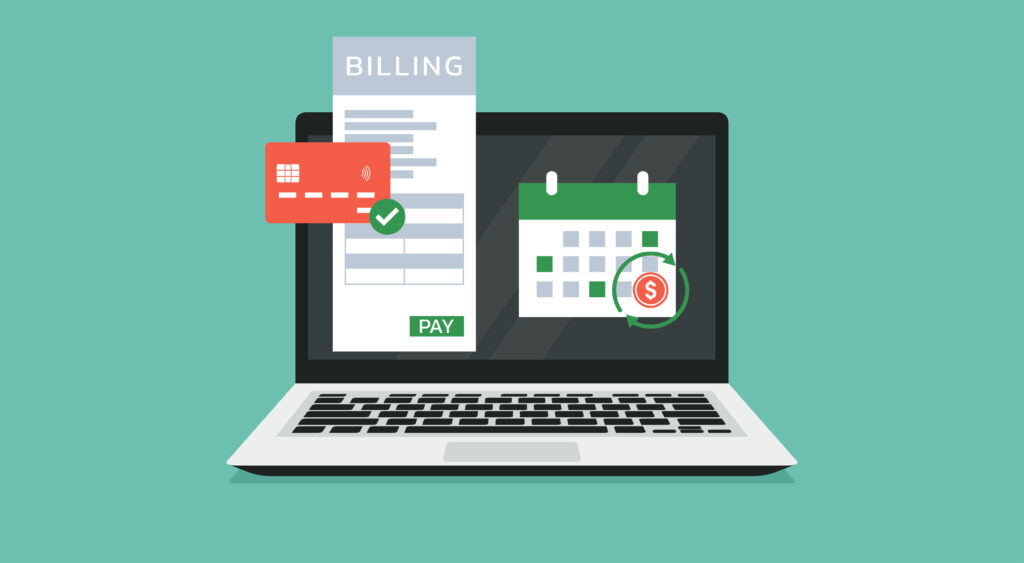In today’s digital economy, the concept of recurring billing has become a cornerstone for many subscription businesses, particularly those offering subscription-based services. From streaming platforms and SaaS companies to membership clubs and utility providers, recurring billing systems ensure a seamless and automated revenue stream, fostering customer retention and business growth.
What is Recurring Billing?
Recurring billing is a payment model that allows businesses to charge their customers automatically at regular intervals, such as weekly, monthly, or annually. Recurring billing involves the storage of payment information and the periodic withdrawal of credit from the customer’s account, making it suitable for any type of business, not just subscription-based services. The primary advantage of recurring billing is its automation, which minimizes the manual effort required for invoicing and payment collection, thereby enhancing operational efficiency.
How the Recurring Billing Process Works
The recurring billing process typically involves several steps:
- Customer Sign-Up: The customer selects a subscription plan and provides their payment details.
- Payment Authorization: The payment gateway authorizes the transaction and stores the payment information securely.
- Recurring Charges: At each billing cycle, the system automatically charges the customer’s payment method.
- Invoice Generation: An invoice is generated and sent to the customer, detailing the charges.
- Payment Processing: The payment is processed, and funds are transferred to the business’s account.
- Subscription Management: The system manages upgrades, downgrades, cancellations, and renewals.
Benefits of Recurring Billing
Predictable Revenue Stream
One of the most significant advantages of recurring billing is the ability to predict revenue, particularly through metrics like monthly recurring revenue. With a recurring billing model, businesses can forecast their income with greater accuracy, allowing for better financial planning and resource allocation.
Improved Cash Flow
Recurring billing ensures a steady stream of recurring revenue, which can greatly improve a company’s cash flow. This is particularly beneficial for businesses with high operational costs or those looking to reinvest in growth initiatives.
Enhanced Customer Retention
By providing a seamless and automated billing experience, businesses can improve customer satisfaction and loyalty. The convenience of recurring payments reduces the likelihood of missed payments, cancellations, and churn.
Efficiency and Automation
Recurring billing systems automate the entire billing process, reducing the need for manual intervention. This not only saves time and resources but also minimizes errors associated with manual billing.
Scalability
As businesses grow, their billing needs become more complex. Recurring billing systems are highly scalable, accommodating an increasing number of customers and transactions without compromising efficiency.
Key Features of Recurring Billing Systems
Automated Billing
Subscription billing is the backbone of recurring billing systems. It ensures that customers are charged at the correct intervals without any manual intervention, streamlining the entire process.
Flexible Billing Cycles
Recurring billing systems offer flexible billing cycles, allowing businesses to set the frequency of charges according to their needs. Whether it’s monthly, quarterly, or annually, these systems can adapt to various billing intervals. Additionally, fixed recurring billing is an option where the same amount is collected from the customer in every payment cycle, making it ideal for services with a fixed price like newspaper subscriptions and gym memberships.
Payment Processing
Collect payments efficiently is crucial for recurring billing. These systems support multiple payment methods, including credit/debit cards, bank transfers, and digital wallets, ensuring that customers can pay using their preferred method.
Invoicing
Automated invoicing is a critical feature of recurring billing systems. It ensures that invoices are generated and sent to customers promptly, providing transparency and maintaining trust.
Subscription Management
Managing subscription services can be complex, especially for businesses with a large customer base. Recurring billing systems offer comprehensive subscription management features, including handling upgrades, downgrades, cancellations, and renewals.
Dunning Management
Dunning management refers to the process of handling failed payments. Advanced recurring billing systems include automated dunning processes that retry failed payments, send reminders to customers, and manage declined transactions effectively.
Challenges of Recurring Billing
While subscription businesses benefit from recurring billing, it also presents certain challenges:
Failed Payments
Payment failures can occur due to expired credit cards, insufficient funds, or other issues. Handling these failures efficiently is crucial to maintaining a steady revenue stream.
Customer Churn
Despite the convenience of recurring billing, businesses may still face customer churn. Identifying the reasons for churn and implementing strategies to reduce it is essential for long-term success.
Compliance and Security
Recurring billing involves handling sensitive payment information, making compliance with regulations like PCI-DSS (Payment Card Industry Data Security Standard) crucial. Ensuring data security and protecting customer information are top priorities.
Integration with Existing Systems
Integrating a recurring billing system with existing business processes and software can be challenging. It requires careful planning and execution to ensure a seamless transition and avoid disruptions.
Best Practices for Implementing Recurring Billing
Choose the Right System
Selecting a recurring billing system that aligns with your business needs is critical. Consider factors like scalability, ease of use, integration capabilities, and customer support when making your decision.
Clear Communication
Communicate clearly with your customers about the billing process. Provide detailed information about billing cycles, payment methods, and how to manage their subscriptions.
Offer Flexible Payment Options
Offering multiple payment options can enhance customer satisfaction and reduce payment failures. Ensure that your recurring billing system supports various payment methods.
Monitor and Optimize
Regularly monitor your recurring billing processes and performance. Use analytics to identify trends, detect issues, and optimize your billing strategies for better results.
Ensure Compliance
Ensure that your recurring billing system complies with relevant regulations and standards. Protect customer data and maintain robust security practices to build trust and avoid legal issues.

Future Trends in Recurring Billing
AI and Machine Learning
Artificial Intelligence (AI) and machine learning are set to revolutionize recurring billing systems. These technologies can enhance fraud detection, optimize payment processing, and provide personalized billing experiences.
Blockchain Technology
Blockchain technology offers increased transparency and security for recurring billing. It can streamline payment processing, reduce fraud, and provide a decentralized ledger for tracking transactions.
Subscription Economy Growth
The subscription economy continues to grow, with more businesses adopting recurring billing models. This trend is expected to drive innovation in billing systems, offering more advanced features and greater flexibility.
Enhanced Customer Experience
Future recurring billing systems will focus more on enhancing the customer experience. This includes offering personalized billing options, improving communication, and providing seamless management of subscriptions.
Conclusion
Recurring billing is a powerful tool for businesses looking to streamline their revenue processes, enhance customer retention, and ensure a predictable cash flow. By understanding its benefits, challenges, and best practices, businesses can leverage recurring billing to drive growth and achieve long-term success. As technology continues to evolve, recurring billing systems will become even more sophisticated, offering new opportunities for innovation and efficiency in the subscription economy.
Quick FAQs about Recurring Billing
Q: What is recurring billing and how does it work?
Recurring billing is a payment model where businesses automatically charge their customers at regular intervals, such as monthly or annually. It involves storing payment information and automatically withdrawing funds from the customer’s account during each billing cycle. This system is commonly used in subscription services and ensures a seamless revenue stream.
Q: What are the benefits of recurring billing for businesses?
Recurring billing provides several advantages, including predictable revenue, improved cash flow, and enhanced customer satisfaction. Automation reduces manual invoicing efforts and minimizes errors, allowing businesses to focus on growth initiatives. Additionally, it supports multiple payment methods, offering convenience to customers.
Q: What challenges do businesses face when implementing recurring billing systems?
Implementing recurring billing can present challenges such as handling payment failures, managing customer churn, ensuring data security, and integrating the system with existing processes. Businesses must also comply with regulations like PCI-DSS to protect sensitive payment information.
Q: How does automated invoicing work in recurring billing systems?
Automated invoicing in recurring billing systems involves generating and sending invoices to customers automatically at each billing cycle. This feature enhances transparency, maintains trust, and ensures timely communication with customers, reducing manual intervention and potential errors.
Q: How does subscription management function in recurring billing systems?
Subscription management involves overseeing the entire lifecycle of a subscription, including upgrades, downgrades, cancellations, and renewals. Recurring billing systems streamline subscription management by automating these processes and providing analytics to optimize customer retention strategies.
Q: What are dunning management practices in billing systems?
Dunning management refers to handling failed payments through automated processes. Advanced systems retry failed transactions, send reminders, and manage declined payments effectively, helping businesses recover lost revenue and maintain customer relationships.
Q: Why is payment method flexibility important in billing systems?
Offering flexible payment options enhances customer satisfaction and reduces payment failures. Recurring billing systems support various payment methods, such as credit cards, bank transfers, and digital wallets, allowing customers to choose their preferred method and ensuring smoother transactions.
Q: What future trends can we expect in recurring billing systems?
Future recurring billing systems will likely incorporate AI and machine learning to enhance fraud detection and provide personalized billing experiences. Blockchain technology may offer increased transparency and security, while the subscription economy continues to grow, driving innovation and flexibility in billing solutions.






